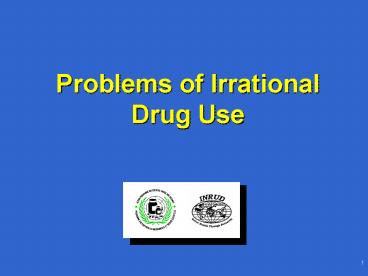Problems of Irrational Drug Use - PowerPoint PPT Presentation
1 / 25
Title:
Problems of Irrational Drug Use
Description:
Cameroon. El Salvador. 0. 1. 2. 3. 4. 5. Average Number of Drugs ... Cameroon. El Salvador. 0. 20. 40. 60. 80. 100 % of Encounters Receiving Antibiotics ... – PowerPoint PPT presentation
Number of Views:1863
Avg rating:3.0/5.0
Title: Problems of Irrational Drug Use
1
Problems of Irrational Drug Use
2
Problems of Irrational Drug UseObjectives
- Identify magnitude and nature of inappropriate
drug utilization - Understand the adverse impacts of inappropriate
use of drugs - Describe factors that influence the
decision-making process - Identify factors that influence the behavior of
prescribers and patients - Discuss specific medication use problems
3
What Is Rational Use of Drugs?
- The rational use of drugs requires that patients
receive medicines appropriate to their clinical
needs, in doses that meet their own individual
requirements, for an adequate period of time, and
at the lowest cost to them and the community.
- (WHO 1988)
- Appropriate indication
- Appropriate drug
- Appropriate administration, dosage, and
duration - Appropriate patient
- Appropriate patient information
- Appropriate evaluation
4
Irrational Use of Drugs Pathology of Prescribing
- The use of drugs when no drug therapy is
indicated - The use of wrong drugs for a specific condition
requiring drug therapy - The use of drugs with doubtful or unproven
efficacy - The use of drugs of uncertain safety status
- Failure to prescribe available, safe, effective
drugs - Incorrect administration, dosages, or duration
5
Examples of Common Inappropriate Prescribing
Practices
- Overuse of antibiotics and antidiarrheals for
nonspecific childhood diarrhea - Indiscriminate use of injections for malaria
- Multiple or overprescription
- Use of antibiotics for mild, nonbacterial
infection, e.g., ARI - Tonics and multivitamins for malnutrition
- Unnecessary use of expensive antihypertensives
6
Components of the Drug Use System
Local
Drug Imports
Manufacture
The Drug Supply
Process
Provider and
Consumer Behavior
Private Physician or
Hospital or
Pharmacist or
Other Practitioner
Health Center
Drug Trader
Illness Patterns
Public
7
Factors Underlying Irrational Use of Drugs
8
Impact of InappropriateUse of Drugs
Reduced quality of therapy
Waste of resources
Risk of unwanted effects
Psychosocial impacts
- reduced availability
- increased cost
- patients rely on unnecessary drugs
- morbidity
- mortality
- adverse reactions
- bacterial resistance
9
Activity 1
Meaning of Appropriate Use
10
Drugs per Case, by Age Group E. Java W.
Kalimantan, Indonesia, 1987
11
Drugs per Case, by DiagnosisE. Java W.
Kalimantan, Indonesia, 1987
Musculoskel
G.I.
Skin
Resp.Dis.
Diarrhea
12
of Patients Receiving AntibioticsE. Java W.
Kalimantan, Indonesia, 1987
13
of Patients Receiving InjectionsE. Java W.
Kalimantan, Indonesia, 1987
None
56
None
26
One
54
Two or More
10
Two or More
20
One
34
Under Age Five
Age Five and Over
14
ARI Treatment PatternE. Java W. Kalimantan,
Indonesia, 1987
15
Other Drug Use Problems
- Incorrect treatment of malaria
- Incorrect use of chloroquin injection
- Poor compliance with TB therapy
- Causes treatment failure and resistant
organisms - Underuse of effective drugs
- Hypertension
- Depression
- Hospital drug use problems
- Antibiotic misuse for surgical prophylaxis
16
Average Number of Drugs per PatientPublic Sector
Drug Use Indicator Studies, 19901993
17
Prescribed as GenericsPublic Sector Drug Use
Indicator Studies 1990-1993
18
Receiving AntibioticsPublic Sector Drug Use
Indicator Studies 1990-1993
19
Receiving InjectionsPublic Sector Drug Use
Indicator Studies 1990-1993
20
Average Consultation TimePublic Sector Drug Use
Indicator Studies 1990-1993
21
Average Dispensing TimePublic Sector Drug Use
Indicator Studies 1990-1993
22
Patients with Drug Dosing KnowledgePublic
Sector Drug Use Indicator Studies 1990-1993
23
of Key Drugs in StockPublic Sector Drug Use
Indicator Studies 1990-1993
24
Activity 2
Identifying a Priority Problem
25
Conclusion
- Drug use is the end of the therapeutic
consultation - Health professionals have responsibility to
ensure that the right drug is prescribed,
dispensed, and taken - Methods exist to measure drug use and to change
practices - Improving drug use improves the quality of care
and frequently lowers cost































